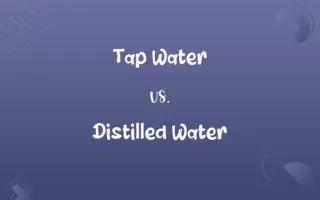Physical Weathering vs. Chemical Weathering: Know the Difference

By Shumaila Saeed || Updated on December 25, 2023
Physical Weathering breaks down rocks mechanically without altering their chemical composition, while Chemical Weathering involves chemical changes that decompose or alter rock's mineral composition.

Key Differences
Physical Weathering involves the breakdown of rocks into smaller pieces through physical forces like temperature changes, water, ice, and wind. Chemical Weathering, in contrast, involves the chemical alteration of the mineral structure of the rock, often through reactions with water and atmospheric gases.
Shumaila Saeed
Dec 10, 2023
Physical Weathering retains the rock's original mineral composition, just in smaller fragments. Chemical Weathering changes the chemical makeup of the rock, often leading to new minerals and soluble substances.
Shumaila Saeed
Dec 10, 2023
Physical Weathering is often driven by thermal expansion, freeze-thaw cycles, and mechanical abrasion. Chemical Weathering is more common in areas with higher temperatures and more rainfall, as warmth and moisture accelerate chemical reactions.
Shumaila Saeed
Dec 10, 2023
Physical Weathering can occur rapidly, such as when rock is split by freeze-thaw action. Chemical Weathering typically occurs more slowly, as it depends on gradual chemical reactions.
Shumaila Saeed
Dec 10, 2023
Physical Weathering is crucial in creating smaller particles that can be transported by natural forces, while Chemical Weathering is important in soil formation and altering the landscape by dissolving and weakening rocks.
Shumaila Saeed
Dec 10, 2023
ADVERTISEMENT
Comparison Chart
Process
Breakdown of rocks through physical forces.
Chemical alteration of rock's mineral structure.
Shumaila Saeed
Dec 10, 2023
Resulting Changes
Retains original mineral composition.
Alters chemical makeup, forming new minerals.
Shumaila Saeed
Dec 10, 2023
Environmental Factors
Influenced by temperature changes, water, ice, and wind.
Accelerated by higher temperatures and moisture.
Shumaila Saeed
Dec 10, 2023
Rate of Occurrence
Can be rapid, like in freeze-thaw cycles.
Generally slower, dependent on chemical reactions.
Shumaila Saeed
Dec 10, 2023
Impact on Landscape
Creates smaller particles for transport.
Important in soil formation and rock dissolution.
Shumaila Saeed
Dec 10, 2023
ADVERTISEMENT
Physical Weathering and Chemical Weathering Definitions
Physical Weathering
This type of weathering is predominant in cold, dry, or very hot environments.
Desert landscapes are often sculpted by physical weathering due to temperature fluctuations.
Shumaila Saeed
Dec 03, 2023
Chemical Weathering
Chemical Weathering is the decomposition or alteration of rock's minerals through chemical reactions.
Limestone caves form largely due to chemical weathering by acidic rainwater.
Shumaila Saeed
Dec 03, 2023
Physical Weathering
Physical Weathering prepares rock for further decomposition and soil formation.
The gradual breakdown of mountainous rocks into gravel is an example of physical weathering.
Shumaila Saeed
Dec 03, 2023
Chemical Weathering
This weathering type is more effective in warm, moist climates.
Tropical rainforests experience rapid chemical weathering due to abundant rainfall and warm temperatures.
Shumaila Saeed
Dec 03, 2023
Physical Weathering
It involves the disintegration of rock without changing its chemical composition.
The sandstone cliffs were shaped through centuries of physical weathering by wind.
Shumaila Saeed
Dec 03, 2023
ADVERTISEMENT
Chemical Weathering
It involves the transformation of rock into new minerals and soluble substances.
The rust-colored streaks on cliff faces are results of chemical weathering.
Shumaila Saeed
Dec 03, 2023
Physical Weathering
Physical Weathering is the mechanical breakdown of rocks into smaller pieces.
Frost wedging caused large boulders to split into smaller fragments.
Shumaila Saeed
Dec 03, 2023
Chemical Weathering
Chemical reactions like hydrolysis, oxidation, and carbonation contribute to chemical weathering.
The smooth, rounded surfaces of granite boulders are often due to chemical weathering.
Shumaila Saeed
Dec 03, 2023
Physical Weathering
Physical Weathering includes processes like freeze-thaw, thermal expansion, and abrasion.
Tree roots growing into cracks in rocks demonstrate physical weathering.
Shumaila Saeed
Dec 03, 2023
Chemical Weathering
Chemical Weathering is key in soil formation and nutrient cycling in ecosystems.
The rich, fertile soils in river valleys are often the product of extensive chemical weathering.
Shumaila Saeed
Dec 03, 2023
Repeatedly Asked Queries
How does frost action contribute to physical weathering?
Frost action occurs when water freezes and expands in rock cracks, exerting pressure and causing the rock to fragment.
Shumaila Saeed
Dec 10, 2023
What is physical weathering?
Physical weathering is the process of breaking down rocks into smaller fragments without changing their chemical composition, primarily through mechanical forces.
Shumaila Saeed
Dec 10, 2023
What is abrasion in physical weathering?
Abrasion is the wearing away of rock surfaces through the mechanical action of wind, water, or other particles.
Shumaila Saeed
Dec 10, 2023
What is chemical weathering?
Chemical weathering is the process in which rocks and minerals break down through chemical reactions, altering their composition.
Shumaila Saeed
Dec 10, 2023
What role does carbonic acid play in chemical weathering?
Carbonic acid, formed when carbon dioxide dissolves in water, can react with minerals like calcite in rocks, causing them to dissolve.
Shumaila Saeed
Dec 10, 2023
What are some common agents of physical weathering?
Common agents of physical weathering include frost, wind, water, temperature changes, and abrasion.
Shumaila Saeed
Dec 10, 2023
What are some common agents of chemical weathering?
Common agents of chemical weathering include water, acids (e.g., carbonic acid), oxygen, and living organisms.
Shumaila Saeed
Dec 10, 2023
How does oxygen contribute to chemical weathering?
Oxygen can oxidize certain minerals, such as iron, leading to the formation of rust and the weakening of rocks.
Shumaila Saeed
Dec 10, 2023
What is the main difference between physical and chemical weathering?
The key difference is that physical weathering involves mechanical forces, while chemical weathering involves chemical reactions.
Shumaila Saeed
Dec 10, 2023
Give an example of physical weathering due to temperature changes.
Daily temperature fluctuations can lead to the expansion and contraction of rocks, causing them to crack and break.
Shumaila Saeed
Dec 10, 2023
Is chemical weathering more prevalent in areas with acid rain?
Yes, acid rain, which contains sulfuric and nitric acids, can accelerate chemical weathering by reacting with rocks and minerals.
Shumaila Saeed
Dec 10, 2023
How do plants contribute to chemical weathering?
Plant roots can release organic acids that contribute to chemical weathering by breaking down minerals.
Shumaila Saeed
Dec 10, 2023
Which type of weathering typically occurs faster in humid environments?
Chemical weathering is typically more rapid in humid environments due to increased exposure to water and dissolved chemicals.
Shumaila Saeed
Dec 10, 2023
Can human activities, like pollution, influence chemical weathering?
Yes, human activities can introduce pollutants that accelerate chemical weathering processes, leading to environmental concerns.
Shumaila Saeed
Dec 10, 2023
How does water contribute to chemical weathering?
Water can dissolve minerals in rocks, leading to their decomposition and alteration.
Shumaila Saeed
Dec 10, 2023
Can physical weathering be observed in deserts?
Yes, physical weathering can occur in deserts through processes like wind erosion and thermal expansion.
Shumaila Saeed
Dec 10, 2023
Why is understanding weathering important in geology and environmental science?
Understanding weathering processes is crucial for interpreting landscape changes, predicting erosion, and studying Earth's surface evolution.
Shumaila Saeed
Dec 10, 2023
In which geological features can physical weathering be prominently observed?
Physical weathering is often observed in the formation of rocky coastlines, talus slopes, and boulder fields.
Shumaila Saeed
Dec 10, 2023
Do physical and chemical weathering always occur independently?
No, physical and chemical weathering often work together to break down rocks, with physical weathering creating fractures that allow chemical weathering to penetrate.
Shumaila Saeed
Dec 10, 2023
Which type of weathering is responsible for the formation of caves?
Chemical weathering, particularly through the dissolution of limestone, leads to the formation of caves.
Shumaila Saeed
Dec 10, 2023
Share this page
Link for your blog / website
HTML
Link to share via messenger
About Author
Written by
Shumaila SaeedShumaila Saeed, an expert content creator with 6 years of experience, specializes in distilling complex topics into easily digestible comparisons, shining a light on the nuances that both inform and educate readers with clarity and accuracy.









































































